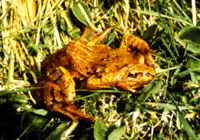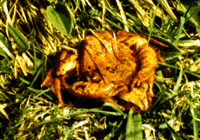

Many species of amphibians are protected by antipredator adaptations, such as cryptic or aposematic colouration, noxious skin secretions and antipredator vocalizations (Altig 1972, Brodie 1978, 1981, Brodie et al. 1979, Formanowicz and Brodie 1979). The classic "unkenreflex" takes its name from the European Bombinas ("Unken" in German) of the family Discoglossidae, and is a response to perceived threat.
The first author observed Rana temporaria engaging in a defensive posture that seems to be more than simply shrinking away from apparent danger and yet not quite a true unkenreflex (Figs. 1 & 2). Burny and Parent (1984) and Garcia-Paris and Esteban (1989) have also recorded a form of unkenreflex in this species. They present photographs showing a posture very similar to those given here.
Conclusions: A number of anurans other than Bombina engage in antipredator postures similar to the unkenreflex to a varying degree. However, since this is usually not a "true unkenreflex" which includes a marked curvature of the spine to facilitate exposure of the ventral surface, it is probably preferable to use the term "partial unkenreflex". While the behaviour seems to be fairly common in North American Ranids, it has only rarely been observed in the European Rana temporaria, although the behaviour observed here seems to be closer to a true unkenreflex than is generally recorded (with the notable exceptions of Burny and Parent 1984 and Garcia-Paris and Esteban 1989). At low temperatures the reflex in Bombina can be incomplete and resemble that of Rana, which suggests that the postures have the same neural pathways and neuromuscular basis in both species (S. Grenard, pers. comm.). The non-specialized, "partial" unkenreflex of R. temporaria, however, has probably not developed further because of the absence of vivid, contrasting ventral colouration, and because of the species' normal recourse to flight when confronted. The species also lacks the vertebral articulations found in Bombina (Garcia-Paris and Esteban 1989) which facilitate the "full" unkenreflex in this genus. We can therefore tentatively postulate that the partial unkenreflex observed in Rana temporaria serves, when flight is unavailable for temperature or other reasons, as a means of momentarily startling a potential predator, at the same time perhaps causing disorientation by the covering of the eyes. Further observations in the field will be neccessary to confirm or refute this assertion.


Fig. 1 and 2: The Unkenreflex in Rana temporaria. Photos by W. Haberl.